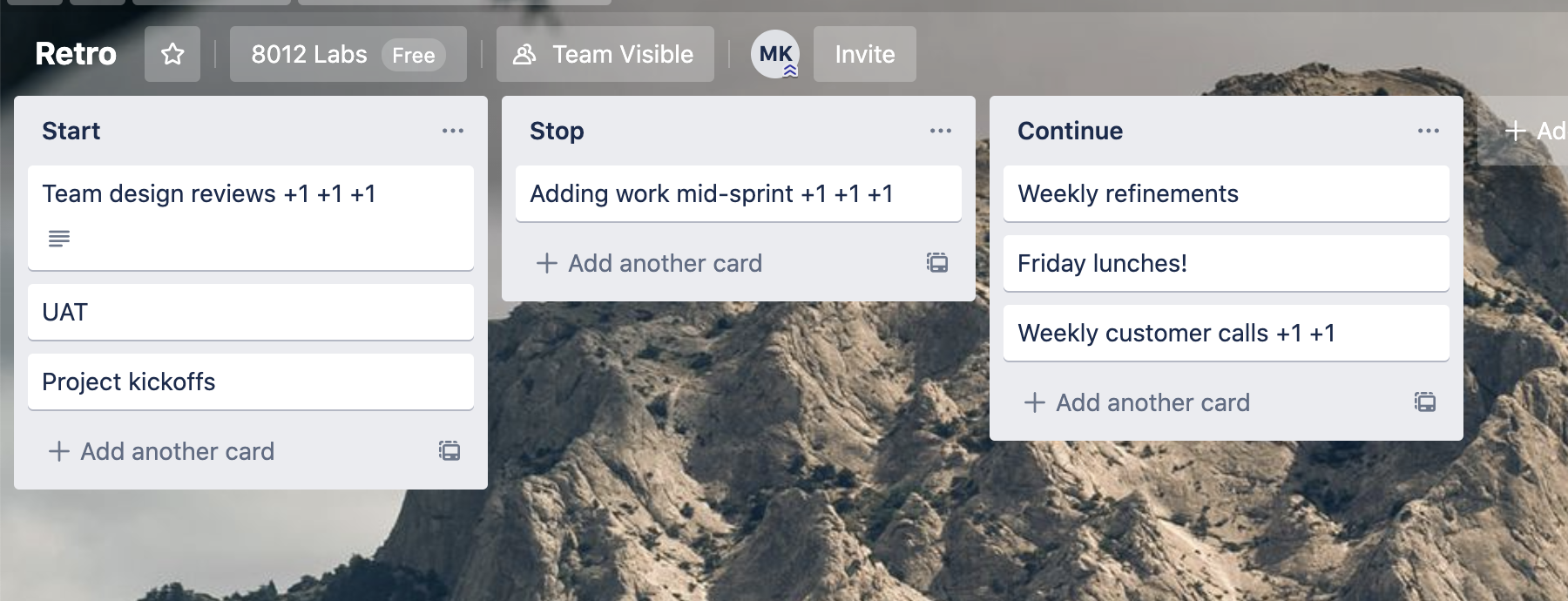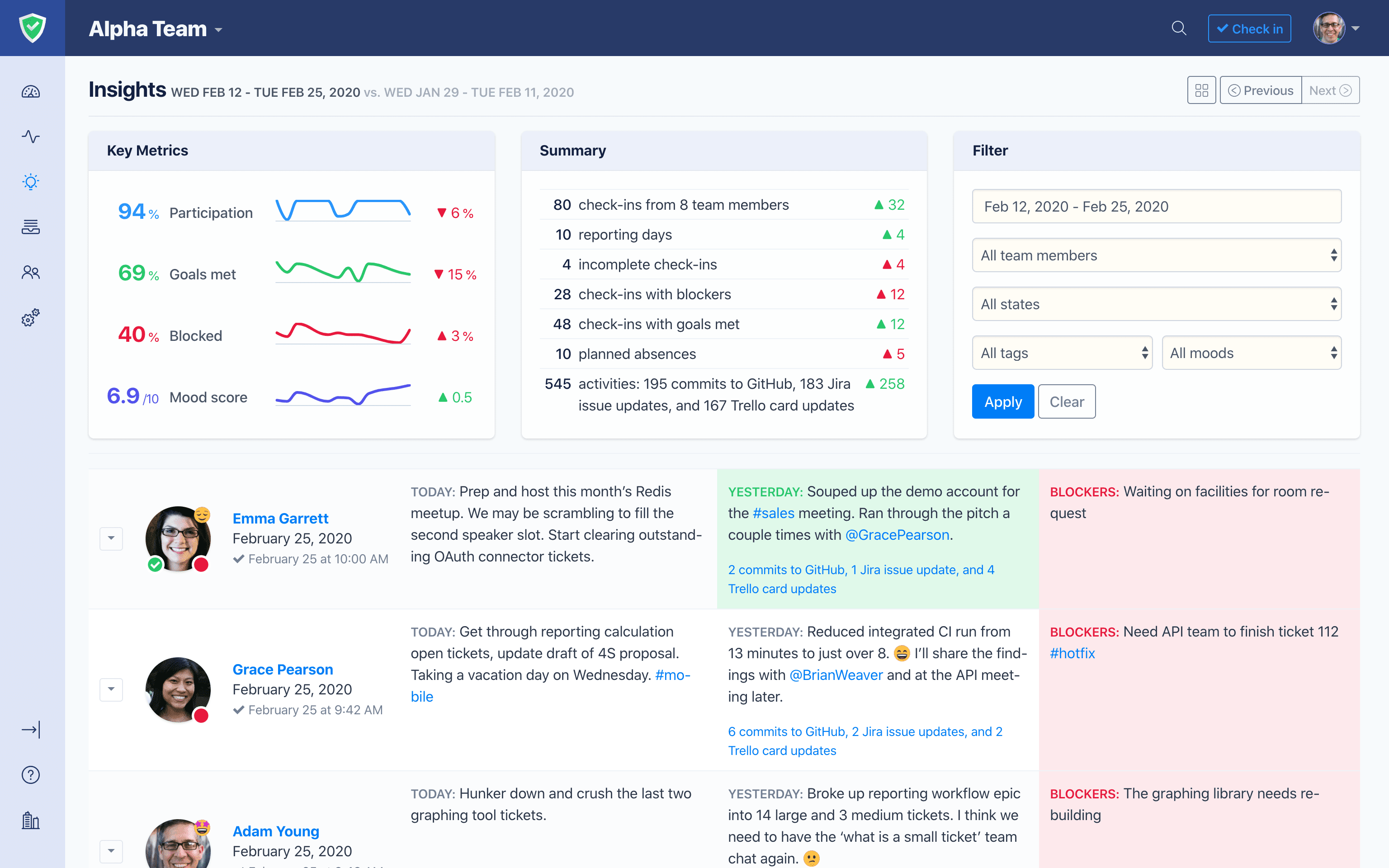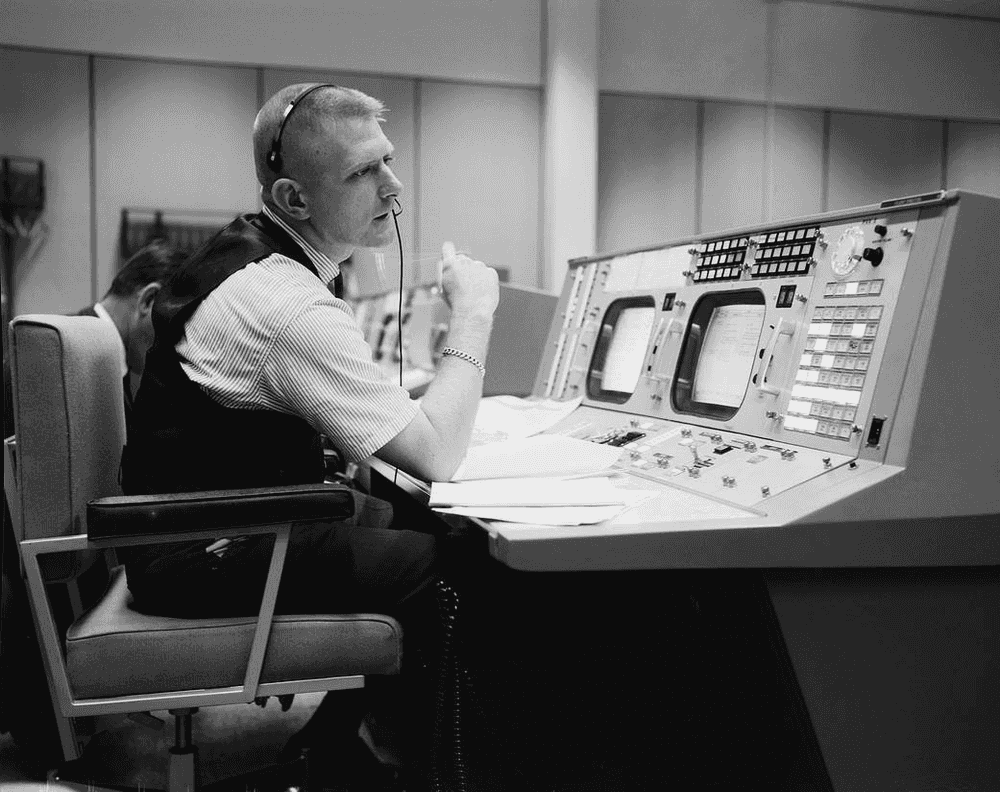Due to Covid-19, more and more companies are choosing (or being forced) to go remote. We’re seeing an uptick in traffic to our site and our blog post on how to run a standup with a remote team has been especially popular. Since people are looking for help with standup meetings, we figure they may also need help with retrospectives (retros for short). That’s why we decided to create a follow-on to our remote standup guide, focused on running effective retros with a remote team.
In this guide, we’ll discuss what retros are, the benefits, common pitfalls to avoid, and a set of activities you can use to run a more engaging remote team retro meeting. We’ll also share some ways that Status Hero can help it be more efficient at the end.
So, what are retrospectives and why have one?
Retrospectives are regular discussions, traditionally done as an “agile ceremony” on a scrum team. They are usually led by a facilitator, often a scrum master or agile coach, and focus on what’s gone well, what hasn’t, and what can be improved. But don’t worry, you don’t need to be a scrum team or practicing agile to benefit from holding regular retrospectives.
The main purpose of a retro is to refine processes on a team and drive continuous improvement, making it more enjoyable to be a part of. They provide a platform to discuss challenges and prevent issues from festering for too long. Without retros, there’s a risk that frustrations will build and engagement will drop. That or you’ll get stuck making the same mistakes time after time.
But it’s not all focused on what to improve. Retros are a great opportunity to celebrate success and recognize team members for their hard work. Recognizing and appreciating each other helps to build trust, collaboration, and psychological safety in the team, which is critical for effective communication, long-term health, and success.
It may seem obvious, but as part of each retrospective, the team should identify and commit to making adjustments where needed. This step is unfortunately overlooked quite often.
How often should you hold a retro?
Most development teams are operating with some sort of regular cadence of planning and execution. In scrum teams that might look like a 2-week sprint. In larger organizations, it may be a monthly cadence. Whatever your work style is, it’s a good idea to have a retro after each cycle. You may also want to hold project-specific retros at the end of large, cross-functional efforts.
If you’re not operating with a regular rhythm, we recommend having a retro every 2-4 weeks. Weekly retros won’t allow for enough time to make changes and waiting more than a month can allow significant issues to fester.
Who should be part of a retro?
Everyone that is part of the “team”. For product development, that’s typically the engineering manager, engineers, product manager, designer, and quality engineering/QA. In a marketing team that might be a project manager, copywriter, designer, and product marketing. Basically, anyone that is collaborating with each other regularly.
The important thing is to make sure the entire team has representation and a chance to contribute, as well as the opportunity to hear from each other. Excluding an integral part of the team is a sure way to breed contempt and resentment between functions.
Common Pitfalls
"We’re remote, so retros don’t work”
The most common pitfall is not having the retro at all. It’s too easy to throw up your hands and assume a remote retro won’t work well. Or that because you’re a distributed team that spans across time zones it’s impossible. Yet some of the largest remote and distributed organizations in the world hold remote retrospectives regularly, both at the team and organizational levels.
“But there’s nothing to discuss”
You might think this, but if you sit back and focus for a while I bet you can come up with some things that slowed you down or made you frustrated recently. We all can. And it’s important to remember that retros aren’t only to discuss what’s gone wrong. They should be used as an opportunity to recognize team members for their contributions and call out things that are working well.
Consistently holding retrospectives will prove worth the investment through stronger team morale and efficiency.
“But we’re too busy”
See above. You need to invest the time and effort to consistently hold retrospectives. There will always be more work to do or an upcoming deadline. Reserve the time to hold your retro so you can continue to improve as a team.
Stop making excuses and just do it.
Inaction
The biggest risk to long-term success with retros is not taking action based on the discussion. It is critical to institute change based on the recommendations of the team. If you don’t, people will quickly realize it and will stop investing any time and effort into them. Oftentimes apathy towards the retro process is because of disappointment with previous results.
We recommend the team to agree to institute at least one change or process improvement each retro and check in on the progress at the next retro to hold each other accountable.
Activities
Retrospectives can be difficult enough to run while in-person, let alone with remote team members. Many activities that work well in-person may feel impossible or overly complex to do while remote. But if you think creatively, you can translate many retro activities to a remote setting.
Tools like Miro and Mural allow you to create digital whiteboards complete with stickies to use. If those aren’t an option, Google Slides with shared editing can be a surprisingly effective collaboration tool.
For activities like Start/Stop/Continue and the 4Ls, tools like Trello or even Google Sheets are all you need for effective collaboration.
Start/Stop/Continue
Start/Stop/Continue is a traditional and basic retrospective exercise. The way it works is each team member contributes their thoughts about what the team should start, stop, and continue. Kind of self-explanatory, right?
For a remote team, we recommend a tool like Trello, Google Sheets, or even a Google Doc works.
Give each team member time to fill in their ideas if working synchronously, or a couple of days if working async. Allow each participant to comment and +1 items to show support. The facilitator should take time to let team members vocalize their contributions and explain them in more detail. To wrap things up, brainstorm and identify 1-3 changes that everyone would like to institute as a result of the discussion.

4LS
The 4Ls is a variant of Start/Stop/Continue. The mechanics and facilitation are the same, but team members are asked to think about four slightly different categories:
- Liked – What did people like about the last cycle? This could be anything from a process tweak to going out for lunch as a team
- Learned – What things did people team learn during the cycle? Examples include discovering a new tool, interesting data, or to customer insights. This category is a nice addition to the standard retro and facilitates knowledge sharing amongst team members.
- Lacked – What felt like it was missing? This could be something like customer research being skipped on a solution that turned out to be missing a core use case.
- Longed for – What do people wish they had? Perhaps this is the ability to work with a new technology or access to date.
By looking at things through the 4Ls you can uncover some alternate issues and ideas for how to improve beyond what you would typically get with Start/Stop/Continue.
Sailboat Retro
When done in-person, the sailboat retro involves drawing a picture of a boat with an island, wind, rocks, and an anchor.
- The island represents the team’s goal. This aspect is often missing from other retro techniques and it helps to assure alignment on the team about the priority.
- The wind represents everything that is helping the team moving forward.
- The rocks are risks. This is another aspect that is often not part of other retro activities.
- The anchor represents what is slowing the team down.
Team members add items to each category and discuss them. While you can use a digital whiteboard tool or Google slide to replicate the in-person experience this activity could also be done with Trello or a Google sheet since team members only need to categorize their thoughts.
As with the other activities, give each team member time to fill in their ideas and then discuss them in more detail. Identify 1-3 changes that the team will implement.
How Status Hero can Help
Part of having an effective retro is being able to look back and easily remember what’s being going on. Sometimes this can be surprisingly hard, especially if you’re doing monthly retros vs something more frequent. By collecting team member’s daily check-ins and activity, Status Hero makes it easy to see trends and insights customized to the timeframe of your retro.
Instead of taking time in the retro asking people to think about what’s been going on, you can start the conversation with data and trends about how your team is performing and, more importantly, how they’re doing in comparison to the last sprint or cycle.
The Insights page allows you to see trends related to participation, goal completion, blockers, integration activity, vacations, and more. You can even see how your team’s mood has trended. Surfacing these insights will help you figure out the most important question - how are we doing and are we getting better?
While viewing the Insights page, use the filter options to view check-ins from the dates of your most recent sprint/cycle. You can also filter by tags or search terms to review check-ins about a specific topic or project. We recommend filtering to see the blocked check-ins so you can have a team discussion about what is slowing you down.

Some things we recommend you look out for:
- Participation - if your team’s participation rate is dropping, it may be an indicator that they’re burning out or lacking motivation. We recommend taking a closer look at workloads and satisfaction within your team.
- Mood - a mood score that is trending down can be an early warning sign that there’s a problem within your team. Introverted team members may be unlikely to speak up but will often display other, more subtle signs. Their mood is one of them.
- Blockers - A high number or significant increase in blockers can be an indicator that there is a systemic, process, or prioritization problem within your team. Perhaps you aren’t refining work enough before starting it, leading to unknowns and surprises.
- Integration activity - Integration activity can give you a sense of how active your team has been vs. previous periods. Are you seeing MRs and issues being completed at the same rate?
Putting it all Together
Now that you’re equipped with tools and techniques to run an effective retro with a remote team, there’s only one thing left to do. Commit to taking action and hold a retro at the end of your next cycle.

